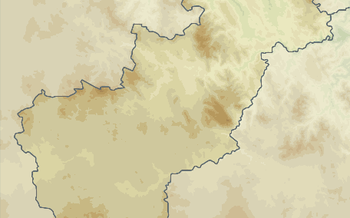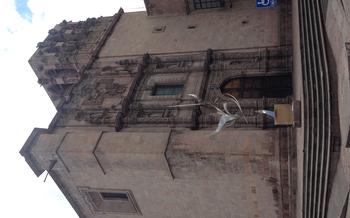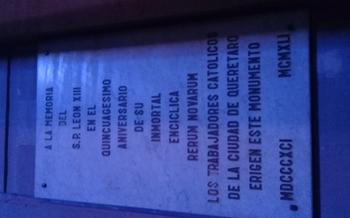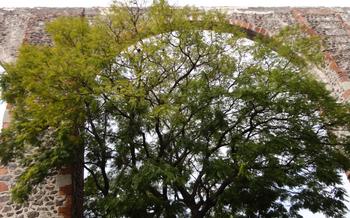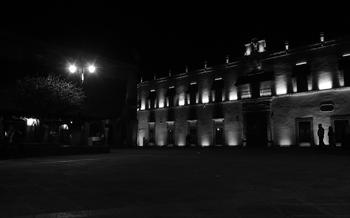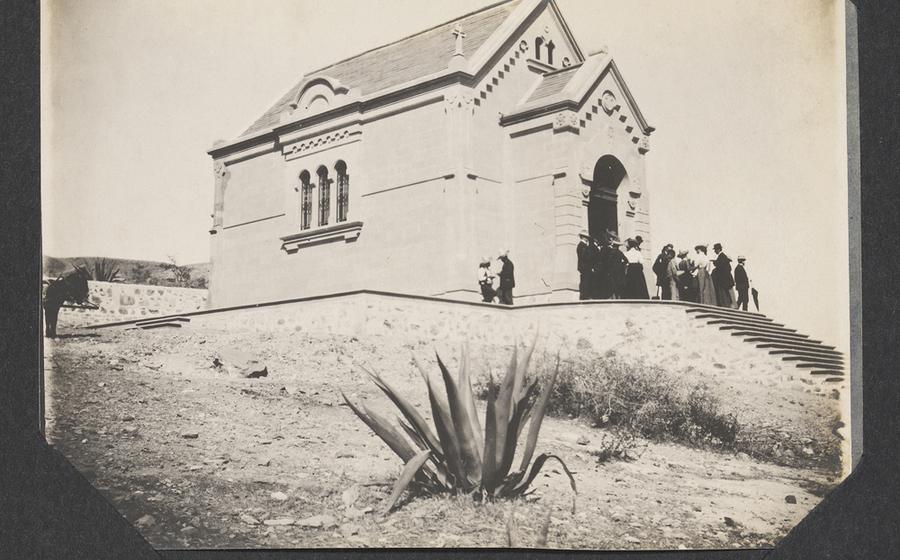
Hill of the Bells
- Historical Significance
- Cerro de las Campanas National Park
- The Aqueduct
- The Regional Museum of Querétaro
- Government Palace
- Plaza de Armas
- The Alameda Hidalgo
- The Querétaro Art Museum
- The Santa Clara Convent
- The Temple of San Francisco
- Plaza Mariano de las Casas : Witness to History
- Historical Significance:
- Architectural Elegance:
- Cultural Events and Festivals:
- Insider Tip:
- The Querétaro Botanical Garden : A Haven for Nature Enthusiasts
- The Route of the Cheeses and Wines
- Insider Tip
Historical Significance
The Hill of the Bells, or Cerro de las Campanas, holds immense historical significance, dating back to pre-Columbian times. It was once the site of an Otomi and Chichimeca settlement, serving as a sacred ceremonial center. During the Spanish conquest and colonization, it became the site of a bloody battle between the Spanish and the indigenous peoples, leading to the establishment of Santiago de Querétaro in 153The hill's pivotal role in Mexico's history earned it the title of a UNESCO World Heritage Site, recognizing its outstanding universal value and cultural heritage.
Cerro de las Campanas National Park
The **Cerro de las Camp, Mexico. It encompasses the iconic hill of the same name, which is home to the city's most recognizable landmarks, including the Aqueduct and the Temple of Santa Rosa de Viterbo. The park offers a serene escape from the urban hustle and bustle, with its lush vegetation, tranquil trails, and breathtaking viewpoints.
Established in 1937, the park covers an area of over 600 acres and is home to a diverse array of flora and fauna. Visitors can explore the park's many hiking trails, which wind through forests of oyamel firs, holm oaks, and junipers. Along the way, they may encounter wildlife such as squirrels, rabbits, and various bird species.
The park also features several viewpoints that offer panoramic views of the city and the surrounding landscape. One of the most popular vantage points is the Mirador del Cerro de las Campanas, which provides a breathtaking vista of the city's colonial architecture and the distant mountains.
The Aqueduct
The Aqueduct is one of the most iconic landmarks of Querétaro. It was built in the 18th century to bring water to the city from the nearby springs of El Marqués. The aqueduct is an impressive feat of engineering, with 74 arches spanning a distance of over 2 kilometers. It is a testament to the ingenuity and perseverance of the people of Querétaro.
The aqueduct has become a symbol of the city and is featured on the city's coat of arms. It is a popular tourist attraction and a great place to take a stroll or enjoy a picnic. The aqueduct is also a UNESCO World Heritage Site, recognized for its historical and cultural significance.
The aqueduct is a beautiful example of colonial architecture, with its elegant arches and intricate stonework. It is a reminder of the rich history of Querétaro and its importance as a major city in the region.
The Regional Museum of Querétaro
Established in 1935, the Regional Museum of Querétaro is housed in a former convent that dates back to the 18th century. The museum's collection encompasses a diverse range of artifacts, providing a glimpse into the rich history and culture of the region.
Archaeological and historical exhibits
The museum's archaeological collection features artifacts from various pre-Columbian cultures, including the Otomi and Chichimeca, who inhabited the region before the Spanish conquest. These artifacts include pottery, stone tools, and jewelry, providing insights into the daily life and customs of these ancient civilizations.
Art and cultural collections
The museum's art collection showcases a variety of paintings, sculptures, and decorative arts from the colonial period to the present day. Visitors can admire works by renowned Mexican artists, such as Miguel Cabrera, José María Velasco, and Hermenegildo Bustos. The museum also houses a collection of traditional costumes, textiles, and furniture, offering a glimpse into the region's vibrant cultural heritage.
Educational programs and workshops
The Regional Museum of Querétaro is committed to promoting education and cultural awareness. It offers a variety of educational programs and workshops for visitors of all ages. These programs include guided tours, lectures, and hands-on activities that explore the museum's collection and the history of the region.
Government Palace
The Government Palace stands as a testament to Querétaro's rich history and architectural heritage. Built in the 18th century, this majestic edifice has served as the seat of the state government since its inception. Its imposing façade showcases intricate Baroque details, featuring elegant columns, ornate balconies, and elaborate carvings that speak to the artistry of its time.
Inside, the Government Palace boasts a grand courtyard adorned with vibrant murals and artwork depicting significant moments from Querétaro's past. These murals, created by renowned Mexican artists, offer a glimpse into the city's struggles for independence and its role as a cradle of Mexican federalism.
Guided tours are available for visitors, providing insights into the history, architecture, and significance of the Government Palace. These tours offer a unique opportunity to witness firsthand the workings of the state government and to appreciate the artistic treasures within its walls.
Public events and ceremonies are often held in the Government Palace, making it a vibrant hub of civic life. Visitors can experience the city's cultural heritage through these events, which showcase traditional dances, music, and performances that celebrate Querétaro's unique identity.
Plaza de Armas
The Plaza de Armas is the heart of Querétaro, a lively gathering place surrounded by historical buildings, landmarks, fountains, and sculptures. It exudes a vibrant atmosphere, attracting locals and tourists alike. The square's centerpiece is the stunning fountain with its intricate design and water jets, adding a touch of elegance to the surroundings.
Strolling along the Plaza de Armas, visitors can admire the architectural wonders of the 18th-century Government Palace, adorned with murals and artwork depicting the city's rich history. The Regional Museum of Querétaro stands proudly, showcasing archaeological and historical exhibits that provide insights into the region's past.
The Plaza de Armas is a stage for cultural events and festivals throughout the year. From traditional folk dances to lively concerts, the square transforms into a vibrant hub of entertainment and celebration. Don't miss the opportunity to join the locals and immerse yourself in the infectious energy of Querétaro's central square.
The Alameda Hidalgo
In the heart of Querétaro's historical center, nestled between the imposing Government Palace and the vibrant Plaza de Armas, lies the Alameda Hidalgo - a verdant oasis of tranquility and local life. Once a colonial-era market square, this urban park has transformed into a beloved gathering place for locals and visitors alike.
As you step into the Alameda Hidalgo, the lush gardens and meandering walkways embrace you with their serene charm. Tall trees cast dappled shadows, providing respite from the sun's embrace, while colorful flowerbeds add vibrant hues to the landscape. The air is filled with the gentle rustle of leaves and the cheerful chirping of birds, creating a symphony of nature amidst the urban bustle.
Strolling along the cobblestone paths, you'll encounter an array of monuments and sculptures that pay homage to Querétaro's rich history and cultural heritage. The Fuente de Neptuno (Fountain of Neptune), with its majestic figure of the Roman god of the sea, stands as a reminder of the city's colonial past. Other notable sculptures include the bust of Miguel Hidalgo y Costilla, a hero of Mexico's independence movement, and the Monumento a la Corregidora, honoring Josefa Ortiz de Domínguez, a key figure in the struggle for independence.
The Alameda Hidalgo is not just a place of historical significance but also a vibrant hub of local life. Families gather for picnics beneath the shade of trees, friends chat and laugh on benches, and children play gleefully on the swings and slides. Street vendors offer a variety of snacks and refreshments, from traditional Mexican delicacies to refreshing beverages, adding to the lively atmosphere of the park.
As the sun begins to set, the Alameda Hidalgo takes on a magical aura. The golden rays illuminate the park, casting long shadows that dance across the lawns. The sound of music fills the air as locals gather for evening concerts or traditional dance performances. The park transforms into a vibrant cultural stage, showcasing the diverse talents and traditions of Querétaro.
The Querétaro Art Museum
The Querétaro Art Museum is a contemporary art space that showcases the works of established and emerging local and international artists. It hosts temporary exhibitions that explore diverse themes and mediums, providing a platform for artistic experimentation and dialogue.
The museum features a variety of artworks, including paintings, sculptures, installations, photography, and mixed media. It aims to promote artistic expression, foster cultural exchange, and educate the public about contemporary art trends and techniques.
The museum also offers educational programs, workshops, and guided tours that delve into the creative process, art history, and the significance of contemporary art in shaping cultural identities and social discourse.
The Santa Clara Convent
The Santa Clara Convent is a must-see attraction in Querétaro, Mexico, boasting historical significance and architectural charm. Founded in 1607, this former convent now houses the Museum of Religious Art, showcasing an exquisite collection of artwork and artifacts. Visitors can marvel at the intricate carvings, paintings, and sculptures that adorn the convent's walls and altars, offering a glimpse into the rich religious heritage of the region. Guided tours provide insights into the history and significance of the convent, while cultural events and exhibitions bring the past to life.
The Temple of San Francisco
The Temple of San Francisco, located in the heart of Querétaro, stands as a testament to the city's rich history and religious heritage. Boasting a unique blend of Gothic and Baroque architectural styles, this magnificent edifice has captured the hearts of visitors for centuries. Its intricately carved stone facade, adorned with delicate reliefs and statues, narrates tales of faith and devotion.
Step inside the temple to marvel at the breathtaking stained glass windows that bathe the interior in a kaleidoscope of colors. These exquisite works of art depict scenes from the Bible and the lives of saints, casting a divine glow upon the sacred space. The intricate artistry and vibrant hues of the windows create an atmosphere of awe and tranquility.
As you wander through the temple, pause to admire the stunning altars that adorn each chapel. Each altar is a masterpiece of craftsmanship, showcasing intricate carvings, gilded details, and religious iconography. The main altar, dedicated to Saint Francis of Assisi, is a sight to behold, with its towering columns, elaborate ornamentation, and a resplendent statue of the saint himself.
The Temple of San Francisco not only holds immense religious significance but also serves as a cultural hub for the city. Throughout the year, the temple hosts concerts, exhibitions, and other cultural events, providing a platform for local artists and musicians to showcase their talents and enrich the cultural tapestry of Querétaro.
Plaza Mariano de las Casas : Witness to History
Historical Significance:
Plaza Mariano de las Casas stands as a testament to Mexico's rich history and pivotal role in shaping the nation's identity. Constructed in the 19th century, this grand square bears witness to the birth of the Mexican Constitution, an event that forever altered the course of the country's destiny. The plaza is named after Mariano de las Casas, a renowned liberal politician who played a crucial role in drafting the Constitution of 1857, a document that enshrined the fundamental principles of freedom, equality, and justice for all Mexicans.
Architectural Elegance:
Beyond its historical significance, Plaza Mariano de las Casas captivates visitors with its architectural splendor. The square is adorned with elegant government buildings, each showcasing a unique blend of neoclassical and modern architectural styles. The most prominent edifice is the State Legislature Building, an imposing structure that houses the local government and exudes an aura of authority. Its grand facade, adorned with intricate carvings and sculptures, reflects the importance of the institution it represents.
Cultural Events and Festivals:
Plaza Mariano de las Casas is not merely a historical relic; it remains a vibrant hub of cultural activity. Throughout the year, the square plays host to a variety of events and festivals that showcase Querétaro's rich cultural heritage. From traditional dance performances and music concerts to art exhibitions and craft fairs, there's always something to captivate and entertain visitors.
Insider Tip:
To fully immerse yourself in the history and culture of Querétaro, time your visit to coincide with one of the many festivals held in Plaza Mariano de las Casas. The most notable is the annual Constitution Day celebration, which takes place every February 5th. On this day, the square transforms into a sea of green, white, and red as locals and tourists alike gather to commemorate the signing of the Constitution and pay homage to the heroes who fought for Mexico's independence.
The Querétaro Botanical Garden : A Haven for Nature Enthusiasts
Nestled in the heart of Querétaro, the Querétaro Botanical Garden is a tranquil oasis that invites visitors to immerse themselves in the beauty and diversity of the region's flora. Located just a short distance from the city center, the garden encompasses over 100 hectares of land and features a wide range of plant species from various ecosystems. Whether you're a nature enthusiast, a botanist, or simply seeking a peaceful escape, the Querétaro Botanical Garden offers a captivating experience that will leave you inspired and rejuvenated.
Stroll along the winding paths that meander through the garden, taking in the vibrant colors and delicate fragrances of the flowers. Discover the unique characteristics of cacti and succulents in the arid garden, marvel at the towering trees of the temperate forest, and immerse yourself in the serene atmosphere of the Japanese garden. With over 1,200 species of plants to explore, the garden provides a window into the rich biodiversity of the region.
Beyond its aesthetic beauty, the Querétaro Botanical Garden plays a crucial role in conservation and education. It serves as a sanctuary for endangered plant species, contributing to the preservation of Mexico's natural heritage. The garden also offers educational programs and workshops for visitors of all ages, promoting an understanding of botany and the importance of protecting our environment.
Whether you're seeking a peaceful retreat from the hustle and bustle of city life or an opportunity to learn more about the wonders of nature, the Querétaro Botanical Garden is a must-visit destination. Take a leisurely walk, enjoy a picnic surrounded by lush greenery, or simply relax and soak in the tranquility of this botanical paradise.
The Route of the Cheeses and Wines
Immerse yourself in the culinary delights of Querétaro on the Route of the Cheeses and Wines, a gastronomic journey that showcases the region's rich flavors and traditions. Indulge in cheese and wine tasting tours, where you'll visit local producers and vineyards, savoring the artisanal cheeses and exquisite wines that Querétaro is renowned for. Learn about the cheese-making and wine-making processes, and discover the secrets behind their unique flavors. Participate in culinary workshops and festivals, where you can learn to create your own cheese and wine pairings, and enjoy live music, local cuisine, and cultural performances. The Route of the Cheeses and Wines is a must-do experience for food and wine enthusiasts, offering a delightful blend of flavors, history, and tradition.
Insider Tip
The best time to visit Querétaro is during the spring (March to May) or fall (September to November) when the weather is mild and pleasant. During this time, you can enjoy outdoor activities and explore the city's many attractions without the summer heat or winter chill.
Querétaro hosts various festivals and events throughout the year, including the Querétaro International Film Festival, the Querétaro Jazz Festival, and the Querétaro Beer Festival. These events offer a chance to immerse yourself in the city's vibrant culture and traditions.
When it comes to accommodation, Querétaro offers a range of options to suit all budgets. From budget-friendly hostels to luxurious hotels, you'll find something that meets your needs. The city also has a well-developed transportation system, making it easy to get around using public buses, taxis, or ride-sharing services.
In terms of food, Querétaro is a foodie's paradise. Be sure to try some of the local specialties, such as enchiladas queretanas, gorditas de maíz quebrado, and nopales en penca. For a unique dining experience, head to the Mercado de la Cruz, a traditional market where you can sample local delicacies and buy fresh produce, cheese, and wine.
Querétaro is a city that has something to offer everyone. Whether you're interested in history, culture, nature, or gastronomy, you'll find plenty to keep you entertained and engaged. So come and explore this vibrant and welcoming city!
